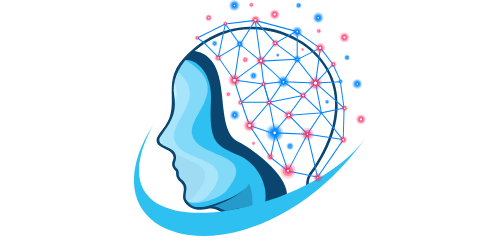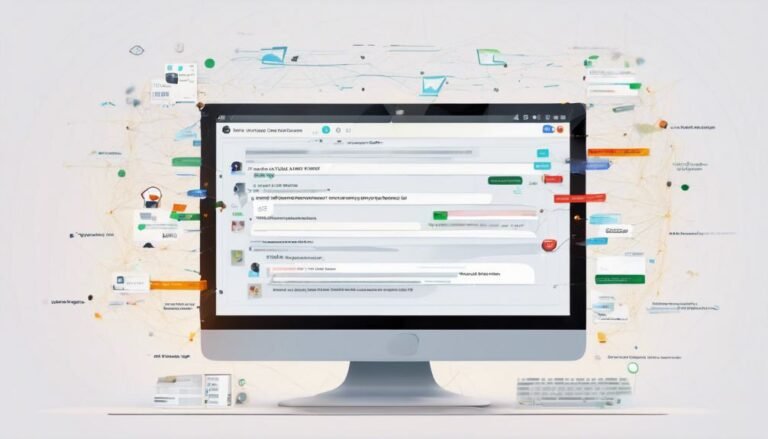AI in Enterprise Risk Management
In the world of enterprise risk management, imagine a scenario where AI-powered algorithms detect subtle patterns indicative of potential fraudulent activities within a company's financial transactions. This cutting-edge technology not only identifies risks but also predicts future threats, revolutionizing how organizations manage uncertainties. The incorporation of AI in risk management is not just a buzzword; it's a strategic imperative that is reshaping the landscape of business resilience. The synergy between AI and risk management holds the key to revealing unprecedented insights and fortifying organizations against unforeseen challenges.
Key Takeaways
- AI enhances risk assessment processes for proactive identification and accurate evaluation.
- AI automates risk assessment, freeing up human resources for strategic decision-making.
- AI detects patterns and anomalies in data for comprehensive risk assessments.
- AI improves data analysis capabilities for informed decision-making in risk management.
- AI enables timely implementation of risk mitigation strategies through predictive analytics.
The Role of AI in Risk Assessment
In enterprise risk management, AI plays a pivotal role in enhancing risk assessment processes by leveraging advanced algorithms and data analytics. Through risk prediction and machine learning, AI enables organizations to proactively identify and assess potential risks, helping them make informed decisions to mitigate these risks effectively.
By analyzing vast datasets rapidly, AI enhances data analysis capabilities, providing more accurate risk evaluation and forecasting.
Machine learning algorithms within AI systems can detect patterns and anomalies within data that human analysts may overlook, leading to more comprehensive risk assessments. This ability to process and interpret large volumes of data in real-time allows for a more agile response to emerging risks.
Furthermore, AI can automate the risk assessment process, freeing up human resources to focus on strategic risk management initiatives.
AI-Powered Fraud Detection
AI's application extends beyond risk assessment to bolster fraud detection capabilities within enterprises through advanced machine learning algorithms and data analytics. By leveraging these technologies, organizations can enhance their fraud prevention strategies and mitigate the risks associated with fraudulent activities.
Machine learning algorithms play an essential role in AI-powered fraud detection by analyzing vast amounts of data to identify patterns, anomalies, and suspicious behavior. These algorithms can quickly adapt to evolving fraud tactics, making them highly effective in detecting fraudulent activities in real-time.
Fraud prevention strategies are greatly strengthened with the implementation of AI-powered fraud detection systems. These systems can automatically flag potential fraud cases, prioritize alerts based on risk levels, and streamline the investigation process for fraud analysts.
Predictive Analytics for Risk
By utilizing predictive analytics, enterprises can proactively identify and mitigate potential risks before they escalate into significant issues. Machine learning applications play a key role in enhancing predictive analytics for risk management. These applications analyze historical data patterns to forecast future outcomes accurately. By leveraging machine learning algorithms, organizations can predict potential risks with greater precision, enabling them to take preemptive actions to minimize their impact.
Data-driven insights derived from predictive analytics help businesses make informed decisions and allocate resources more effectively. By analyzing vast amounts of data, organizations can identify trends, patterns, and anomalies that may indicate potential risks on the horizon. This proactive approach allows businesses to implement risk mitigation strategies in a timely manner, reducing the likelihood of costly disruptions.
AI in Compliance Monitoring
You need to take into account the role of AI in compliance monitoring, especially in regulatory checks and automated compliance tracking.
AI technology can streamline processes, enhance accuracy, and provide real-time insights into compliance status.
AI for Regulatory Checks
Implementing artificial intelligence for regulatory checks enhances the efficiency and accuracy of compliance monitoring within enterprises. AI for regulatory audits and compliance automation is revolutionizing how organizations meet regulatory requirements. By leveraging machine learning in risk management, regulatory technology solutions can analyze vast amounts of data quickly and accurately, ensuring adherence to complex regulations.
AI streamlines the process of regulatory checks by automating the identification of potential compliance issues. Through continuous monitoring and real-time analysis, AI systems can detect anomalies or deviations from regulatory standards promptly. This proactive approach allows organizations to address compliance issues swiftly, minimizing the risk of penalties or reputational damage.
Furthermore, AI for regulatory checks enables enterprises to stay updated with evolving regulations. These systems can adapt to changing compliance requirements, ensuring that organizations are always in alignment with the latest regulatory guidelines.
Automated Compliance Tracking
Automated compliance tracking with AI transforms how organizations monitor and guarantee adherence to regulatory requirements, enhancing efficiency and accuracy in compliance management. Compliance automation streamlines processes by leveraging AI algorithms to continuously monitor regulatory changes and make sure that policies and procedures are up to date. This proactive approach minimizes the risk of non-compliance and potential penalties.
Regulatory tracking becomes more effective through AI integration, enabling real-time updates and alerts on any changes that could impact the organization's operations. By automating compliance tracking, organizations can allocate resources more efficiently, focusing on high-risk areas that require immediate attention. This targeted risk monitoring enhances the overall compliance strategy and reduces the likelihood of regulatory violations.
Furthermore, AI-powered compliance tracking systems offer advanced analytics capabilities, providing valuable insights into compliance trends and potential areas of improvement. By leveraging data-driven decision-making, organizations can enhance their compliance efforts and adapt quickly to evolving regulatory landscapes. Automated compliance tracking with AI is a strategic investment that guarantees organizations stay ahead in the complex world of regulatory compliance.
Enhancing Decision-Making With AI
You can leverage AI for risk assessment to enhance your decision-making processes by gaining deeper insights into potential risks and their impact on your organization.
With AI-driven risk monitoring, you can continuously track and analyze data to identify emerging risks in real-time, enabling proactive decision-making to mitigate potential threats.
AI for Risk Assessment
Utilizing artificial intelligence for risk assessment can greatly enhance the decision-making process within enterprise risk management. Machine learning algorithms play an essential role in identifying patterns and trends within vast datasets, enabling organizations to proactively implement risk mitigation strategies. By automating risk assessment processes, AI minimizes human error and provides real-time insights into potential risks, allowing for timely and informed decision-making.
Natural language processing techniques further enhance risk assessment by analyzing unstructured data sources such as news articles, social media, and industry reports. This enables organizations to gain a thorough understanding of external factors that may impact their risk landscape. AI-driven risk assessment automation not only increases efficiency but also improves the accuracy and depth of risk analysis.
Incorporating AI into risk assessment empowers enterprises to make data-driven decisions, prioritize risk management efforts, and adapt swiftly to changing risk scenarios. By leveraging machine learning algorithms and natural language processing techniques, organizations can strengthen their risk assessment capabilities and enhance overall risk management strategies.
Ai-Driven Risk Monitoring
Implementing AI-driven risk monitoring enhances decision-making within enterprise risk management by providing real-time insights and predictive analytics to mitigate potential risks effectively. Machine learning plays a pivotal role in this process by analyzing vast amounts of data to identify patterns and trends that humans might overlook.
Through advanced algorithms, AI systems can predict potential risks with a high degree of accuracy, enabling organizations to proactively address issues before they escalate.
Data analysis is at the core of AI-driven risk monitoring, allowing for continuous monitoring of various risk factors across different business functions. By leveraging AI technologies, companies can automate the monitoring process, freeing up valuable time for risk managers to focus on strategic decision-making.
Real-time risk monitoring provides instant notifications and alerts when anomalies are detected, empowering organizations to respond swiftly to emerging threats.
Automation of Risk Identification
Automating the identification of risks within an enterprise is a crucial step towards improving efficiency and accuracy in risk management processes. By employing machine learning algorithms, organizations can streamline the process of risk prediction and identification.
Machine learning models can analyze vast amounts of data to detect patterns and anomalies that might indicate potential risks. These models can also be trained to automatically generate automated alerts when unusual activities or deviations from normal behavior are detected, enabling proactive risk management.
The automation of risk identification not only saves time but also guarantees a more thorough and consistent approach to identifying potential threats to the business. By leveraging AI technologies, organizations can enhance their ability to detect risks early on, allowing for timely mitigation strategies to be implemented.
Through the continuous learning capabilities of machine learning algorithms, the accuracy of risk identification can be continuously improved, providing a dynamic and adaptive risk management framework for the organization.
AI Solutions for Cybersecurity
AI solutions play a pivotal role in bolstering cybersecurity defenses within enterprises by leveraging advanced technologies to detect and respond to potential threats. Utilizing AI threat intelligence, organizations can stay ahead of cyber threats by continuously analyzing vast amounts of data to identify patterns indicative of potential attacks. This proactive approach enhances cyber defense mechanisms, allowing for quicker responses to emerging risks.
Moreover, AI plays an essential role in data breach prevention by implementing robust security measures that safeguard sensitive information from unauthorized access. Through advanced algorithms, AI systems can detect anomalies in user behavior or network traffic, signaling possible security breaches before they escalate.
Furthermore, AI-powered tools excel in malware detection, swiftly identifying and mitigating malicious software that poses a threat to organizational cybersecurity. By automatically scanning networks for suspicious activities and known malware signatures, AI reinforces the overall security posture of enterprises, reducing the likelihood of successful cyber attacks.
Real-Time Risk Monitoring With AI
Enhancing enterprise risk management strategies, real-time risk monitoring with AI provides proactive insights into potential threats and vulnerabilities. By leveraging AI algorithms and real-time data, organizations can achieve continuous monitoring of their risk landscape.
AI-powered systems analyze vast amounts of data in real-time, enabling the identification of patterns and anomalies that may signify emerging risks.
One key advantage of real-time risk monitoring with AI is the ability to receive instant risk alerts. Instead of relying on periodic risk assessments, AI algorithms can detect changes in risk factors as they occur, allowing for immediate response and mitigation efforts. This proactive approach enhances an organization's agility in addressing potential threats promptly.
Furthermore, real-time data analysis enables a more dynamic risk management strategy, adapting to the evolving nature of risks in today's fast-paced business environment.
Implementing AI in Risk Mitigation
To effectively bolster your risk mitigation efforts, integrating AI technologies into your existing frameworks is paramount. AI risk modeling and risk prediction play a pivotal role in enhancing your organization's ability to identify and address potential risks proactively.
By leveraging machine learning in risk management, you can automate the process of analyzing vast amounts of data to detect patterns and anomalies that may indicate emerging risks. This predictive capability allows you to take preemptive measures to mitigate risks before they escalate into significant issues.
Incorporating AI into your risk mitigation strategies enables you to progress beyond traditional reactive approaches and shift towards a more proactive risk prevention model. Machine learning algorithms can continuously learn from new data inputs, improving their accuracy in identifying potential risks over time.
Conclusion
To summarize, AI revolutionizes enterprise risk management by providing a powerful toolkit for proactive risk assessment, fraud detection, predictive analytics, and compliance monitoring. With AI-driven solutions, organizations can enhance decision-making processes, automate risk identification, and strengthen cybersecurity measures.
Implementing AI in risk mitigation strategies allows for real-time monitoring and effective threat prevention. Like a beacon in the storm, AI illuminates the path to a safer and more secure business environment.







